tow VAUXHALL ADAM 2015.5 Owner's Guide
[x] Cancel search | Manufacturer: VAUXHALL, Model Year: 2015.5, Model line: ADAM, Model: VAUXHALL ADAM 2015.5Pages: 233, PDF Size: 6.98 MB
Page 192 of 233
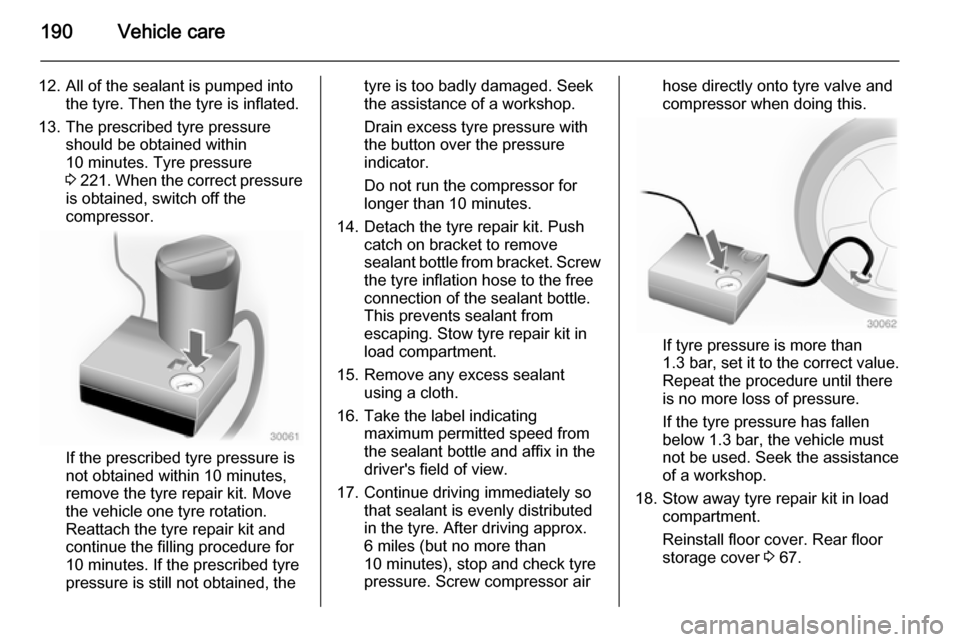
190Vehicle care
12. All of the sealant is pumped intothe tyre. Then the tyre is inflated.
13. The prescribed tyre pressure should be obtained within
10 minutes. Tyre pressure
3 221 . When the correct pressure
is obtained, switch off the
compressor.
If the prescribed tyre pressure is
not obtained within 10 minutes,
remove the tyre repair kit. Move
the vehicle one tyre rotation.
Reattach the tyre repair kit and
continue the filling procedure for
10 minutes. If the prescribed tyre
pressure is still not obtained, the
tyre is too badly damaged. Seek
the assistance of a workshop.
Drain excess tyre pressure with
the button over the pressure indicator.
Do not run the compressor for
longer than 10 minutes.
14. Detach the tyre repair kit. Push catch on bracket to remove
sealant bottle from bracket. Screw
the tyre inflation hose to the free
connection of the sealant bottle.
This prevents sealant from
escaping. Stow tyre repair kit in
load compartment.
15. Remove any excess sealant using a cloth.
16. Take the label indicating maximum permitted speed from
the sealant bottle and affix in the
driver's field of view.
17. Continue driving immediately so that sealant is evenly distributedin the tyre. After driving approx.
6 miles (but no more than 10 minutes), stop and check tyre
pressure. Screw compressor airhose directly onto tyre valve and
compressor when doing this.
If tyre pressure is more than
1.3 bar , set it to the correct value.
Repeat the procedure until there
is no more loss of pressure.
If the tyre pressure has fallen
below 1.3 bar, the vehicle must
not be used. Seek the assistance
of a workshop.
18. Stow away tyre repair kit in load compartment.
Reinstall floor cover. Rear floor
storage cover 3 67.
Page 195 of 233
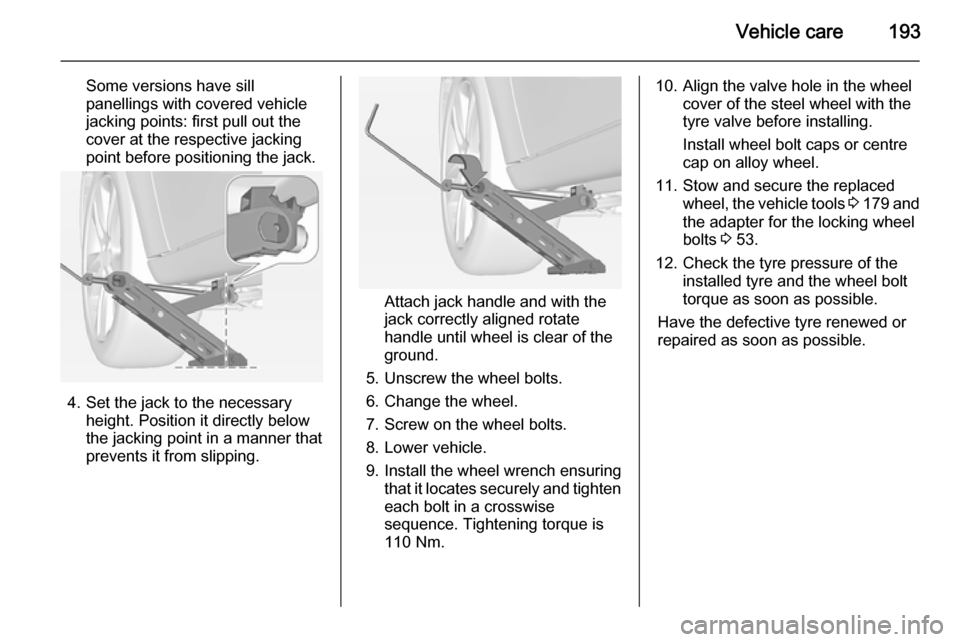
Vehicle care193
Some versions have sill
panellings with covered vehicle
jacking points: first pull out the
cover at the respective jacking
point before positioning the jack.
4. Set the jack to the necessary height. Position it directly below
the jacking point in a manner that
prevents it from slipping.
Attach jack handle and with the
jack correctly aligned rotate handle until wheel is clear of theground.
5. Unscrew the wheel bolts.
6. Change the wheel.
7. Screw on the wheel bolts.
8. Lower vehicle.
9. Install the wheel wrench ensuring that it locates securely and tighten
each bolt in a crosswise
sequence. Tightening torque is
110 Nm.
10. Align the valve hole in the wheel cover of the steel wheel with the
tyre valve before installing.
Install wheel bolt caps or centre
cap on alloy wheel.
11. Stow and secure the replaced wheel, the vehicle tools 3 179 and
the adapter for the locking wheel
bolts 3 53.
12. Check the tyre pressure of the installed tyre and the wheel bolt
torque as soon as possible.
Have the defective tyre renewed or
repaired as soon as possible.
Page 198 of 233
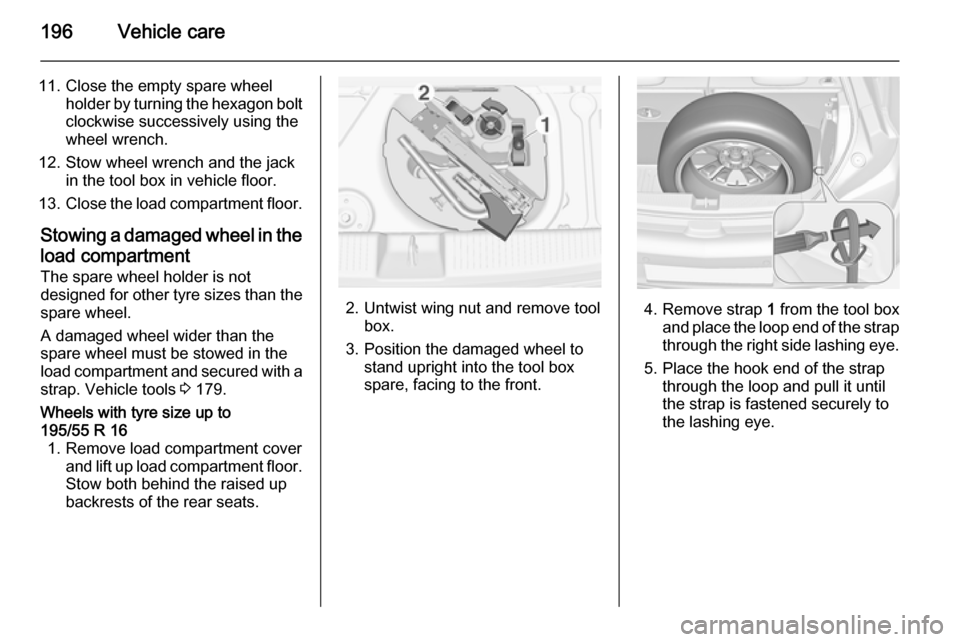
196Vehicle care
11. Close the empty spare wheelholder by turning the hexagon boltclockwise successively using the
wheel wrench.
12. Stow wheel wrench and the jack in the tool box in vehicle floor.
13. Close the load compartment floor.
Stowing a damaged wheel in the
load compartment The spare wheel holder is not
designed for other tyre sizes than the
spare wheel.
A damaged wheel wider than the
spare wheel must be stowed in the
load compartment and secured with a strap. Vehicle tools 3 179.Wheels with tyre size up to
195/55 R 16 1. Remove load compartment cover and lift up load compartment floor.
Stow both behind the raised up
backrests of the rear seats.
2. Untwist wing nut and remove tool box.
3. Position the damaged wheel to stand upright into the tool box
spare, facing to the front.4. Remove strap 1 from the tool box
and place the loop end of the strap
through the right side lashing eye.
5. Place the hook end of the strap through the loop and pull it until
the strap is fastened securely to
the lashing eye.
Page 200 of 233
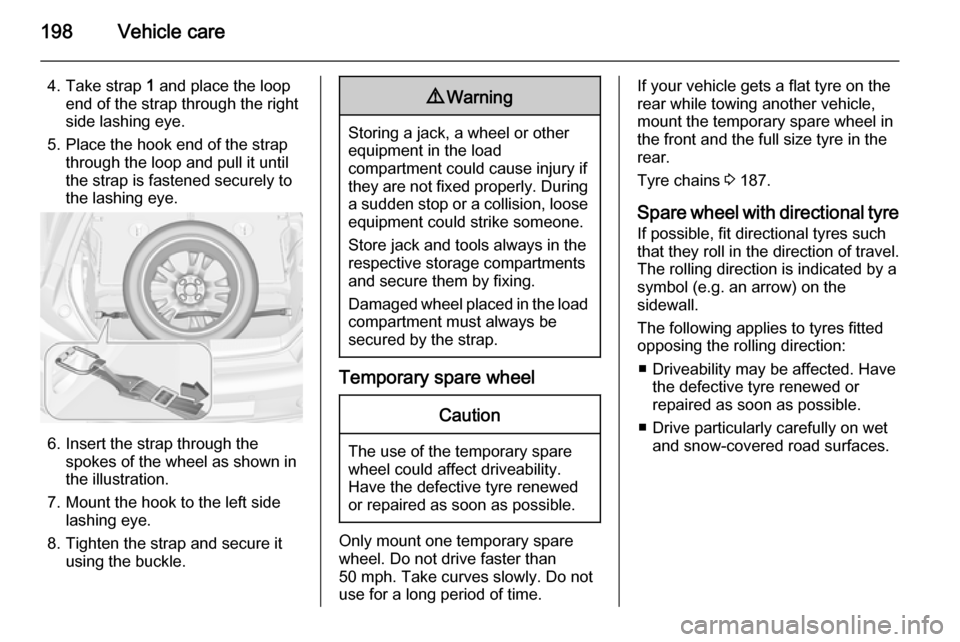
198Vehicle care
4. Take strap 1 and place the loop
end of the strap through the right
side lashing eye.
5. Place the hook end of the strap through the loop and pull it until
the strap is fastened securely to
the lashing eye.
6. Insert the strap through the spokes of the wheel as shown in
the illustration.
7. Mount the hook to the left side lashing eye.
8. Tighten the strap and secure it using the buckle.
9 Warning
Storing a jack, a wheel or other
equipment in the load
compartment could cause injury if they are not fixed properly. During a sudden stop or a collision, looseequipment could strike someone.
Store jack and tools always in the
respective storage compartments
and secure them by fixing.
Damaged wheel placed in the load
compartment must always be
secured by the strap.
Temporary spare wheel
Caution
The use of the temporary spare
wheel could affect driveability.
Have the defective tyre renewed
or repaired as soon as possible.
Only mount one temporary spare
wheel. Do not drive faster than
50 mph. Take curves slowly. Do not
use for a long period of time.
If your vehicle gets a flat tyre on the
rear while towing another vehicle,
mount the temporary spare wheel in
the front and the full size tyre in the
rear.
Tyre chains 3 187.
Spare wheel with directional tyre If possible, fit directional tyres such
that they roll in the direction of travel.
The rolling direction is indicated by a
symbol (e.g. an arrow) on the
sidewall.
The following applies to tyres fitted
opposing the rolling direction:
■ Driveability may be affected. Have the defective tyre renewed or
repaired as soon as possible.
■ Drive particularly carefully on wet and snow-covered road surfaces.
Page 202 of 233

200Vehicle care
3. Connect the black lead to thenegative terminal of the booster
battery.
4. Connect the other end of the black
lead to a vehicle grounding point,
such as the engine block or an
engine mounting bolt. Connect as far away from the discharged
vehicle battery as possible,
however at least 60 cm.
Route the leads so that they cannot
catch on rotating parts in the engine
compartment.
To start the engine: 1. Start the engine of the vehicle providing the jump.
2. After 5 minutes, start the other engine. Start attempts should be
made for no longer than
15 seconds at an interval of 1 minute.
3. Allow both engines to idle for approx. 3 minutes with the leads
connected.4. Switch on electrical consumers (e.g. headlights, heated rear
window) of the vehicle receiving
the jump start.
5. Reverse above sequence exactly when removing leads.Towing
Towing the vehicle The towing eye is stowed with thevehicle tools 3 179.Adam
1. Disengage the cap by pushing at
the marked position.
Page 203 of 233

Vehicle care201
2. Screw in the towing eye as far asit will go until it stops in a
horizontal position.
3. Attach a tow rope – or better still a
tow rod – to the towing eye.
Adam Rocks
1. Disengage the small cap with a screwdriver at the marked
position.
2. Screw in the towing eye as far as it will go until it stops in a
horizontal position.
3. Attach a tow rope – or better still a
tow rod – to the towing eye.General
The towing eye must only be used for
towing and not for recovering the
vehicle.
Switch on ignition to release steering
wheel lock and to permit operation of
brake lights, horn and windscreen
wiper.
Transmission in neutral.Caution
Drive slowly. Do not drive jerkily.
Excessive tractive force can
damage the vehicle.
When the engine is not running,
considerably more force is needed to
brake and steer.
To prevent the entry of exhaust gases from the towing vehicle, switch on the
air recirculation and close the
windows.
Page 204 of 233
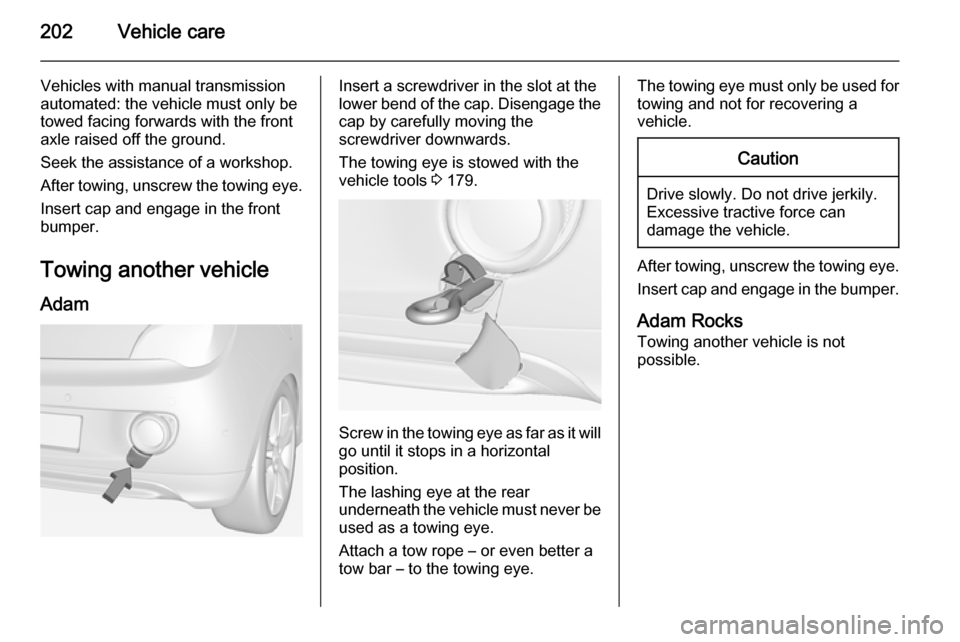
202Vehicle care
Vehicles with manual transmission
automated: the vehicle must only be
towed facing forwards with the front
axle raised off the ground.
Seek the assistance of a workshop. After towing, unscrew the towing eye.
Insert cap and engage in the front
bumper.
Towing another vehicle AdamInsert a screwdriver in the slot at the
lower bend of the cap. Disengage the cap by carefully moving the
screwdriver downwards.
The towing eye is stowed with the
vehicle tools 3 179.
Screw in the towing eye as far as it will
go until it stops in a horizontal
position.
The lashing eye at the rear
underneath the vehicle must never be used as a towing eye.
Attach a tow rope – or even better a
tow bar – to the towing eye.
The towing eye must only be used for
towing and not for recovering a
vehicle.Caution
Drive slowly. Do not drive jerkily.
Excessive tractive force can
damage the vehicle.
After towing, unscrew the towing eye.
Insert cap and engage in the bumper.
Adam Rocks
Towing another vehicle is not possible.
Page 231 of 233

229
SSafety belts ................................... 38
Seat adjustment ....................... 7, 35
Seat belt ........................................ 8
Seat belt reminder .......................85
Seat belts ..................................... 38
Seat folding .................................. 36
Seat position ................................ 34
Selector lever ............................. 130
Service ....................................... 121
Service display ............................ 82
Service information ....................207
Service vehicle soon .................... 87
Side airbag system ......................44
Side blind spot alert ....................150
Sidelights .................................... 104
Side turn signal lights ................172
Spare wheel ............................... 194
Speed limiter............................... 140
Speedometer ............................... 80
Starting and operating ................122
Starting off ................................... 17
Starting the engine ............123, 129
Steering wheel adjustment ......9, 72
Steering wheel controls ...............72
Stop-start system........................ 124
Storage ......................................... 53
Storage compartments .................53
Sunroof ........................................ 31Sun visors .................................... 31
Symbols ......................................... 4
T
Tachometer ................................. 80
Tail lights ................................... 169
Three-point seat belt .................... 39
Tools .......................................... 179
Top-tether fastening eyes ............52
Towing ........................................ 200
Towing another vehicle .............202
Towing the vehicle .....................200
Traction Control system ............. 134
Transmission ............................... 16
Transmission display .................129
Tread depth ............................... 185
Trip odometer .............................. 80
Turn and lane-change signals ...107
Turn signal ................................... 85
Tyre chains ................................ 187
Tyre designations ......................181
Tyre pressure ............................ 181
Tyre pressure monitoring system ............................... 88, 182
Tyre pressures ........................... 221
Tyre repair kit ............................. 187
U
Ultrasonic parking assist ...... 88, 141
Upholstery .................................. 205Upshift.......................................... 87
Using this manual ..........................3
V Vehicle battery ........................... 163
Vehicle checks............................ 159
Vehicle data ................................ 212
Vehicle data recording and privacy ..................................... 223
Vehicle dimensions .................... 219
Vehicle Identification Number ....210
Vehicle jack ................................ 179
Vehicle messages .......................97
Vehicle personalisation .............100
Vehicle security ............................ 26
Vehicle specific data ......................3
Vehicle storage ........................... 158
Vehicle tools ............................... 179
Vehicle unlocking ........................... 6 Vehicle weight ........................... 218
Ventilation ................................... 112
W Warning chimes ........................... 99
Warning lights ............................... 80
Warning triangle .......................... 69
Washer and wiper systems .........14
Washer fluid ............................... 162
Wheel changing .........................191
Wheel covers ............................. 186